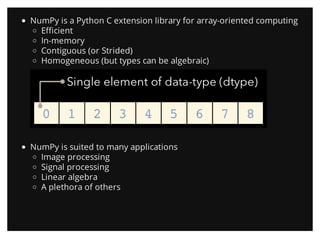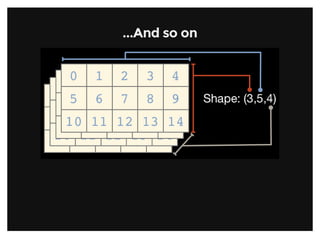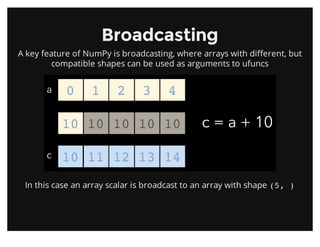Introduction to NumPy (PyData SV 2013)
- 1. Introduction toIntroduction to NumPyNumPy Bryan Van de VenBryan Van de Ven
- 2. What is NumPyWhat is NumPy
- 3. NumPy is a Python C extension library for array-oriented computing Efficient In-memory Contiguous (or Strided) Homogeneous (but types can be algebraic) NumPy is suited to many applications Image processing Signal processing Linear algebra A plethora of others
- 4. NumPy is the foundation of theNumPy is the foundation of the python scientific stackpython scientific stack
- 6. Quick StartQuick Start In [1]: import numpy as np In [2]: a = np.array([1,2,3,4,5,6,7,8,9]) In [3]: a Out[3]: array([1, 2, 3, 4, 5, 6, 7, 8, 9]) In [4]: b = a.reshape((3,3)) In [5]: b Out[5]: array([[1, 2, 3], [4, 5, 6], [7, 8, 9]]) In [6]: b * 10 + 4 Out[6]: array([[14, 24, 34], [44, 54, 64], [74, 84, 94]])
- 7. Array ShapeArray Shape One dimensional arrays have a 1-tuple forOne dimensional arrays have a 1-tuple for their shapetheir shape
- 8. ...Two dimensional arrays have a 2-tuple...Two dimensional arrays have a 2-tuple
- 9. ...And so on...And so on
- 10. Array Element Type (dtype)Array Element Type (dtype) NumPy arrays comprise elements of a single data type The type object is accessible through the .dtype attribute Here are a few of the most important attributes of dtype objects dtype.byteorder — big or little endian dtype.itemsize — element size of this dtype dtype.name — a name for this dtype object dtype.type — type object used to create scalars There are many others...
- 11. Array dtypes are usually inferred automatically But can also be specified explicitly In [16]: a = np.array([1,2,3]) In [17]: a.dtype Out[17]: dtype('int64') In [18]: b = np.array([1,2,3,4.567]) In [19]: b.dtype Out[19]: dtype('float64') In [20]: a = np.array([1,2,3], dtype=np.float32) In [21]: a.dtype Out[21]: dtype('int64') In [22]: a Out[22]: array([ 1., 2., 3.], dtype=float32)
- 12. NumPy Builtin dtype HierarchyNumPy Builtin dtype Hierarchy np.datetime64 is a new addition in NumPy 1.7
- 13. Array CreationArray Creation Explicitly from a list of values As a range of values By specifying the number of elements In [2]: np.array([1,2,3,4]) Out[2]: array([1, 2, 3, 4]) In [3]: np.arange(10) Out[3]: array([0, 1, 2, 3, 4, 5, 6, 7, 8, 9]) In [4]: np.linspace(0, 1, 5) Out[4]: array([ 0. , 0.25, 0.5 , 0.75, 1. ])
- 14. Zero-initialized One-initialized Uninitialized In [4]: np.zeros((2,2)) Out[4]: array([[ 0., 0.], [ 0., 0.]]) In [5]: np.ones((1,5)) Out[5]: array([[ 1., 1., 1., 1., 1.]]) In [4]: np.empty((1,3)) Out[4]: array([[ 2.12716633e-314, 2.12716633e-314, 2.15203762e-314]])
- 15. Constant diagonal value Multiple diagonal values In [6]: np.eye(3) Out[6]: array([[ 1., 0., 0.], [ 0., 1., 0.], [ 0., 0., 1.]]) In [7]: np.diag([1,2,3,4]) Out[7]: array([[1, 0, 0, 0], [0, 2, 0, 0], [0, 0, 3, 0], [0, 0, 0, 4]])
- 16. Array Memory LayoutArray Memory Layout
- 17. Indexing and SlicingIndexing and Slicing
- 19. NumPy array indices can also take an optional stride
- 20. Array ViewsArray Views Simple assigments do not make copies of arrays (same semantics as Python). Slicing operations do not make copies either; they return views on the original array. Array views contain a pointer to the original data, but may have different shape or stride values. Views always have flags.owndata equal to False. In [2]: a = np.arange(10) In [3]: b = a[3:7] In [4]: b Out[4]: array([3, 4, 5, 6]) In [5]: b[:] = 0 In [6]: a Out[6]: array([0, 1, 3, 0, 0, 0, 0, 7, 8, 9]) In [7]: b.flags.owndata Out[7]: False
- 21. Universal Functions (ufuncs)Universal Functions (ufuncs) NumPy ufuncs are functions that operate element-wise on one or more arrays ufuncs dispatch to optimized C inner-loops based on array dtype
- 22. NumPy has many built-in ufuncsNumPy has many built-in ufuncs comparison: <, <=, ==, !=, >=, > arithmetic: +, -, *, /, reciprocal, square exponential: exp, expm1, exp2, log, log10, log1p, log2, power, sqrt trigonometric: sin, cos, tan, acsin, arccos, atctan hyperbolic: sinh, cosh, tanh, acsinh, arccosh, atctanh bitwise operations: &, |, ~, ^, left_shift, right_shift logical operations: and, logical_xor, not, or predicates: isfinite, isinf, isnan, signbit other: abs, ceil, floor, mod, modf, round, sinc, sign, trunc
- 23. AxisAxis Array method reductions take an optional axis parameter that specifies over which axes to reduce axis=None reduces into a single scalar In [7]: a.sum () Out[7]: 105
- 24. axis=None is the default
- 25. axis=0 reduces into the zeroth dimension axis=0 reduces into the first dimension In [8]: a.sum(axis=0) Out[8]: array([15, 18, 21, 24, 27]) In [9]: a.sum(axis=1) Out[9]: array([10, 35, 60])
- 26. BroadcastingBroadcasting A key feature of NumPy is broadcasting, where arrays with different, but compatible shapes can be used as arguments to ufuncs In this case an array scalar is broadcast to an array with shape (5, )
- 27. A slightly more involved broadcasting example in two dimensions Here an array of shape (3, 1) is broadcast to an array with shape (3, 2)
- 28. Broadcasting RulesBroadcasting Rules In order for an operation to broadcast, the size of all the trailing dimensions for both arrays must either: be equal OR be one A (1d array): 3 B (2d array): 2 x 3 Result (2d array): 2 x 3 A (2d array): 6 x 1 B (3d array): 1 x 6 x 4 Result (3d array): 1 x 6 x 4 A (4d array): 3 x 1 x 6 x 1 B (3d array): 2 x 1 x 4 Result (4d array): 3 x 2 x 6 x 4
- 29. Square Peg in a Round HoleSquare Peg in a Round Hole If the dimensions do not match up, np.newaxis may be useful In [16]: a = np.arange(6).reshape((2, 3)) In [17]: b = np.array([10, 100]) In [18]: a * b --------------------------------------------------------------------------- ValueError Traceback (most recent call last) in () ----> 1 a * b ValueError: operands could not be broadcast together with shapes (2,3) (2) In [19]: b[:,np.newaxis].shape Out[19]: (2, 1) In [20]: a *b[:,np.newaxis] Out[20]: array([[ 0, 10, 20], [300, 400, 500]])
- 30. Array MethodsArray Methods Predicates a.any(), a.all() Reductions a.mean(), a.argmin(), a.argmax(), a.trace(), a.cumsum(), a.cumprod() Manipulation a.argsort(), a.transpose(), a.reshape(...), a.ravel(), a.fill(...), a.clip(...) Complex Numbers a.real, a.imag, a.conj()
- 31. Fancy IndexingFancy Indexing NumPy arrays may be used to index into other arrays In [2]: a = np.arange(15).reshape((3,5)) In [3]: a Out[3]: array([[ 0, 1, 2, 3, 4], [ 5, 6, 7, 8, 9], [10, 11, 12, 13, 14]]) In [4]: i = np.array([[0,1], [1, 2]]) In [5]: j = np.array([[2, 1], [4, 4]]) In [6]: a[i,j] Out[6]: array([[ 2, 6], [ 9, 14]])
- 32. Boolean arrays can also be used as indices into other arrays In [2]: a = np.arange(15).reshape((3,5)) In [3]: a Out[3]: array([[ 0, 1, 2, 3, 4], [ 5, 6, 7, 8, 9], [10, 11, 12, 13, 14]]) In [4]: b = (a % 3 == 0) In [5]: b Out[5]: array([[ True, False, False, True, False], [False, True, False, False, True], [False, False, True, False, False]], dtype=bool) In [6]: a[b] Out[6]: array([ 0, 3, 6, 9, 12])
- 33. NumPy FunctionsNumPy Functions Data I/O fromfile, genfromtxt, load, loadtxt, save, savetxt Mesh Creation mgrid, meshgrid, ogrid Manipulation einsum, hstack, take, vstack
- 34. Array SubclassesArray Subclasses numpy.ma — Masked arrays numpy.matrix — Matrix operators numpy.memmap — Memory-mapped arrays numpy.recarray — Record arrays
- 35. Other SubpackagesOther Subpackages numpy.fft — Fast Fourier transforms numpy.polynomial — Efficient polynomials numpy.linalg — Linear algebra cholesky, det, eig, eigvals, inv, lstsq, norm, qr, svd numpy.math — C standard library math functions numpy.random — Random number generation beta, gamma, geometric, hypergeometric, lognormal, normal, poisson, uniform, weibull
- 36. ExamplesExamples
- 37. FFTFFT import numpy as np t = np.linspace(0,120,4000) PI = np.pi signal = 12*np.sin(3 * 2*PI*t) # 3 Hz signal += 6*np.sin(8 * 2*PI*t) # 8 Hz signal += 1.5*np.random.random(len(t)) # noise FFT = abs(np.fft.fft(signal)) freqs = np.fft.fftfreq(signal.size, t[1]-t[0])
- 39. DemosDemos
- 40. ResourcesResources These slides are currently available at http://docs.scipy.org/doc/numpy/reference/ http://docs.scipy.org/doc/numpy/user/index.html http://www.scipy.org/Tentative_NumPy_Tutorial http://www.scipy.org/Numpy_Example_List https://github.com/ContinuumIO/tutorials/blob/master/IntrotoNumPy.pdf
- 41. The EndThe End Many thanks toMany thanks to Ben Zaitlin Stéfan van der Walt Amy Troschinetz Maggie Mari Travis Oliphant Questions?Questions?






![Quick StartQuick Start
In [1]: import numpy as np
In [2]: a = np.array([1,2,3,4,5,6,7,8,9])
In [3]: a
Out[3]: array([1, 2, 3, 4, 5, 6, 7, 8, 9])
In [4]: b = a.reshape((3,3))
In [5]: b
Out[5]:
array([[1, 2, 3],
[4, 5, 6],
[7, 8, 9]])
In [6]: b * 10 + 4
Out[6]:
array([[14, 24, 34],
[44, 54, 64],
[74, 84, 94]])](https://image.slidesharecdn.com/introductiontonumpy-130416133754-phpapp02/85/Introduction-to-NumPy-PyData-SV-2013-6-320.jpg)




![Array dtypes are usually inferred automatically
But can also be specified explicitly
In [16]: a = np.array([1,2,3])
In [17]: a.dtype
Out[17]: dtype('int64')
In [18]: b = np.array([1,2,3,4.567])
In [19]: b.dtype
Out[19]: dtype('float64')
In [20]: a = np.array([1,2,3], dtype=np.float32)
In [21]: a.dtype
Out[21]: dtype('int64')
In [22]: a
Out[22]: array([ 1., 2., 3.], dtype=float32)](https://image.slidesharecdn.com/introductiontonumpy-130416133754-phpapp02/85/Introduction-to-NumPy-PyData-SV-2013-11-320.jpg)

![Array CreationArray Creation
Explicitly from a list of values
As a range of values
By specifying the number of elements
In [2]: np.array([1,2,3,4])
Out[2]: array([1, 2, 3, 4])
In [3]: np.arange(10)
Out[3]: array([0, 1, 2, 3, 4, 5, 6, 7, 8, 9])
In [4]: np.linspace(0, 1, 5)
Out[4]: array([ 0. , 0.25, 0.5 , 0.75, 1. ])](https://image.slidesharecdn.com/introductiontonumpy-130416133754-phpapp02/85/Introduction-to-NumPy-PyData-SV-2013-13-320.jpg)
![Zero-initialized
One-initialized
Uninitialized
In [4]: np.zeros((2,2))
Out[4]:
array([[ 0., 0.],
[ 0., 0.]])
In [5]: np.ones((1,5))
Out[5]: array([[ 1., 1., 1., 1., 1.]])
In [4]: np.empty((1,3))
Out[4]: array([[ 2.12716633e-314, 2.12716633e-314, 2.15203762e-314]])](https://image.slidesharecdn.com/introductiontonumpy-130416133754-phpapp02/85/Introduction-to-NumPy-PyData-SV-2013-14-320.jpg)
![Constant diagonal value
Multiple diagonal values
In [6]: np.eye(3)
Out[6]:
array([[ 1., 0., 0.],
[ 0., 1., 0.],
[ 0., 0., 1.]])
In [7]: np.diag([1,2,3,4])
Out[7]:
array([[1, 0, 0, 0],
[0, 2, 0, 0],
[0, 0, 3, 0],
[0, 0, 0, 4]])](https://image.slidesharecdn.com/introductiontonumpy-130416133754-phpapp02/85/Introduction-to-NumPy-PyData-SV-2013-15-320.jpg)




![Array ViewsArray Views
Simple assigments do not make copies of arrays (same semantics as
Python). Slicing operations do not make copies either; they return views
on the original array.
Array views contain a pointer to the original data, but may have different
shape or stride values. Views always have flags.owndata equal to
False.
In [2]: a = np.arange(10)
In [3]: b = a[3:7]
In [4]: b
Out[4]: array([3, 4, 5, 6])
In [5]: b[:] = 0
In [6]: a
Out[6]: array([0, 1, 3, 0, 0, 0, 0, 7, 8, 9])
In [7]: b.flags.owndata
Out[7]: False](https://image.slidesharecdn.com/introductiontonumpy-130416133754-phpapp02/85/Introduction-to-NumPy-PyData-SV-2013-20-320.jpg)


![AxisAxis
Array method reductions take an optional axis parameter that specifies
over which axes to reduce
axis=None reduces into a single scalar
In [7]: a.sum
()
Out[7]: 105](https://image.slidesharecdn.com/introductiontonumpy-130416133754-phpapp02/85/Introduction-to-NumPy-PyData-SV-2013-23-320.jpg)

![axis=0 reduces into the zeroth dimension
axis=0 reduces into the first dimension
In [8]: a.sum(axis=0)
Out[8]: array([15, 18, 21, 24,
27])
In [9]: a.sum(axis=1)
Out[9]: array([10, 35, 60])](https://image.slidesharecdn.com/introductiontonumpy-130416133754-phpapp02/85/Introduction-to-NumPy-PyData-SV-2013-25-320.jpg)



![Square Peg in a Round HoleSquare Peg in a Round Hole
If the dimensions do not match up, np.newaxis may be useful
In [16]: a = np.arange(6).reshape((2, 3))
In [17]: b = np.array([10, 100])
In [18]: a * b
---------------------------------------------------------------------------
ValueError Traceback (most recent call last)
in ()
----> 1 a * b
ValueError: operands could not be broadcast together with shapes (2,3) (2)
In [19]: b[:,np.newaxis].shape
Out[19]: (2, 1)
In [20]: a *b[:,np.newaxis]
Out[20]:
array([[ 0, 10, 20],
[300, 400, 500]])](https://image.slidesharecdn.com/introductiontonumpy-130416133754-phpapp02/85/Introduction-to-NumPy-PyData-SV-2013-29-320.jpg)

![Fancy IndexingFancy Indexing
NumPy arrays may be used to index into other arrays
In [2]: a = np.arange(15).reshape((3,5))
In [3]: a
Out[3]:
array([[ 0, 1, 2, 3, 4],
[ 5, 6, 7, 8, 9],
[10, 11, 12, 13, 14]])
In [4]: i = np.array([[0,1], [1, 2]])
In [5]: j = np.array([[2, 1], [4, 4]])
In [6]: a[i,j]
Out[6]:
array([[ 2, 6],
[ 9, 14]])](https://image.slidesharecdn.com/introductiontonumpy-130416133754-phpapp02/85/Introduction-to-NumPy-PyData-SV-2013-31-320.jpg)
![Boolean arrays can also be used as indices into other arrays
In [2]: a = np.arange(15).reshape((3,5))
In [3]: a
Out[3]:
array([[ 0, 1, 2, 3, 4],
[ 5, 6, 7, 8, 9],
[10, 11, 12, 13, 14]])
In [4]: b = (a % 3 == 0)
In [5]: b
Out[5]:
array([[ True, False, False, True, False],
[False, True, False, False, True],
[False, False, True, False, False]], dtype=bool)
In [6]: a[b]
Out[6]: array([ 0, 3, 6, 9, 12])](https://image.slidesharecdn.com/introductiontonumpy-130416133754-phpapp02/85/Introduction-to-NumPy-PyData-SV-2013-32-320.jpg)




![FFTFFT
import numpy as np
t = np.linspace(0,120,4000)
PI = np.pi
signal = 12*np.sin(3 * 2*PI*t) # 3 Hz
signal += 6*np.sin(8 * 2*PI*t) # 8 Hz
signal += 1.5*np.random.random(len(t)) # noise
FFT = abs(np.fft.fft(signal))
freqs = np.fft.fftfreq(signal.size, t[1]-t[0])](https://image.slidesharecdn.com/introductiontonumpy-130416133754-phpapp02/85/Introduction-to-NumPy-PyData-SV-2013-37-320.jpg)



